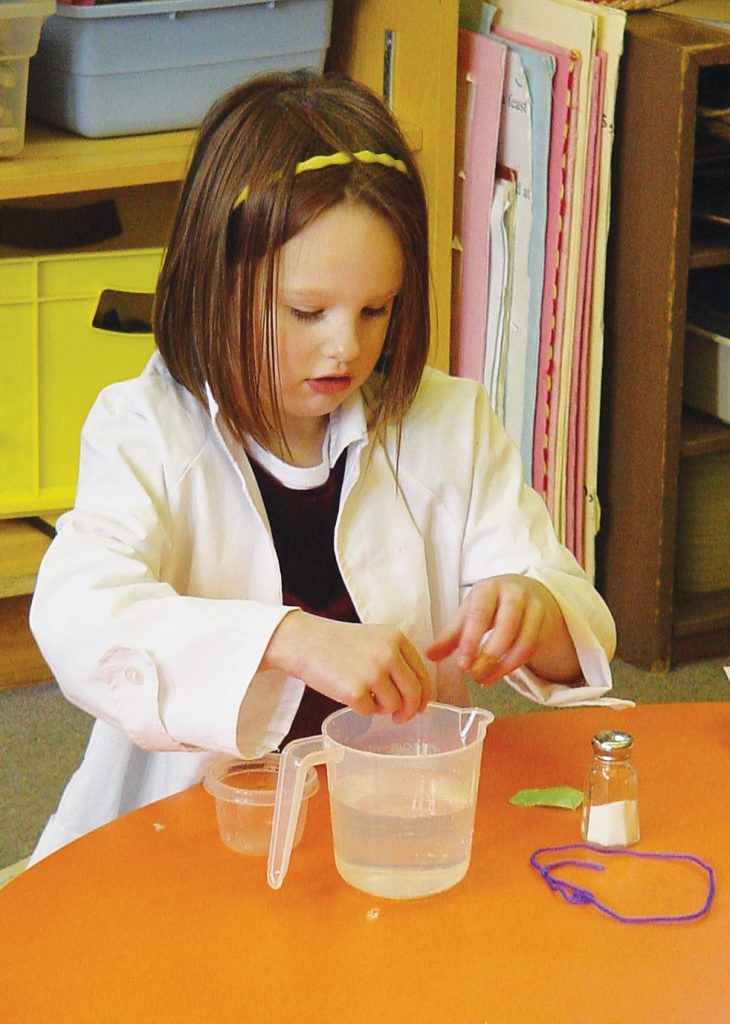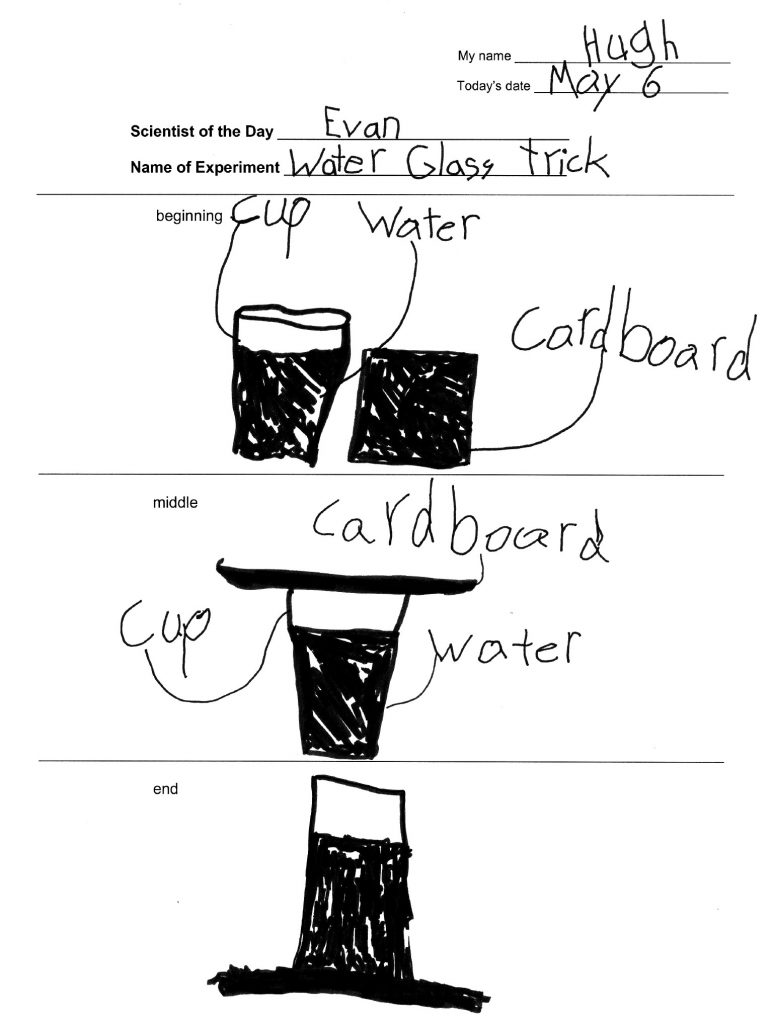The Presentation
“What do you predict will happen when I lift the fingers of the glove so the baking soda will fall into the vinegar?” Lisa asks her classmates.
 She knows just what to do and say because she practised at home.
She knows just what to do and say because she practised at home.
James: “I think the vinegar will fizz.”
Lisa: “That’s one idea. Who has another?”
Chen: “I think the glove will get big.”
Lisa: “Maybe…who has another idea?”
Rose: “Maybe the glove will shoot into the air, like the cork did in Jack’s experiment.”
Lisa is careful not to say “That’s right” or “That’s wrong” so that everyone will continue to think and will feel free to express their ideas. After one or two more students have spoken, Lisa holds the latex glove firmly around the mouth of the jar and raises the fingers. The baking soda falls into the jar and the glove inflates rather dramatically, much to the delight of the students. Now it is time for Lisa to ask another question, “Who has an idea about why the glove inflated?” At the end of the discussion, Lisa or her teacher speak briefly about the science involved. Many of the scientific concepts are very sophisticated, so often students will not totally understand the explanations, but they will remember that there was a reason for the reaction: it’s not just magic!
 A Science Notebook with a Difference
A Science Notebook with a Difference
Now it is time for students to take out their science notebooks. Each page has space for the name of the scientist and the name of the experiment, and the rest is divided into three parts, ready for the student’s three drawings of the experiment they just witnessed. What happened at the beginning, in the middle, and at the end of the demonstration? They label their often-creative visual summaries. Most students enjoy this activity and, with experience, these summaries improve. Students become better able to select the important parts of the demonstrations, and their drawings become clearer and easier to read. By not asking students to write out the traditional “What equipment and materials were used—what I observed—what I learned,” students remain enthusiastic about the science program, and the drawings they produce require a good deal of focus and thought. It’s a highly intellectual activity.
The Program
In my class, a student has a chance to be the Scientist of the Day one afternoon a week. A week or two before the scheduled presentation, that student takes home a photocopy of a description of one of the experiments I have collected—experiments that are simple, use materials usually found in the home, aren’t dangerous, don’t require freezing, boiling or waiting, and can be performed by young children. Attached to the description is a letter explaining the program and giving the date and time of the student’s presentation at school. The parents help their child assemble the needed materials and practise the experiment at home so he or she will be ready to present it to the class on the assigned day. Following the instructions on the page I send home, the parents or caregivers help them learn when to pause to ask questions so the students in the class will be engaged in observing, predicting, describing and hypothesizing. All will be “thinking like scientists!”
There is an important social component to this study, since students support and encourage each other and converse about what they observe. The Scientists of the Day have successful public speaking experiences when they demonstrate science experiments that capture the attention and interest of their classmates.
Teacher First
Teachers will likely choose to present an experiment or two themselves before beginning the program. Future Scientists of the Day will have a model to emulate when the teacher sets up the equipment, follows the steps necessary to complete the experiment, asks for predictions and explanations about it along the way, and responds to the answers appropriately. It is especially important for the teacher to stress the importance of listening to all answers respectfully. When the presenter and all students respect each others’ contributions, all will feel free to participate in the discussions.
After each of the first few presentations, the teacher should conduct a class discussion about the drawings that students will be doing in their science notebooks. (“What happened first? What would you say was the middle part, and what might you draw in that box? How did the experiment end? How will you show that?”) After one or two of these discussions, many students will be eager to begin their drawings without this preparation, but some may continue to want to participate in discussions a few more times. Students can decide for themselves if they wish to join the discussion group.
 The Day of the Presentation
The Day of the Presentation
If it is possible to reorganize the room for this program so that all can see the experiment well, perhaps by placing chairs in a double semi-circular row in front of a low table, it will help make the weekly event more special, as well as making it easier for students to see.
The Scientist of the Day dons a lab coat (a man’s old white dress shirt will do) and sets up the equipment on the table. Parents are welcome to attend their child’s presentation, but it is the student who is in charge. Parents, cameras in hand, are a part of the audience. If the young scientist needs a little assistance, the teacher can help out and then step back to let the student continue.
Experiments
There are many books of experiments available at libraries and in bookstores, and many on websites, some with video clips. Be sure that the ones selected can be completed in 5 or 10 minutes by a young child in front of the class.
The Future
Everyone enjoys presenting and watching these demonstrations. Some students may be inspired to continue their studies to become “not just for a day” scientists!
ABOUT THE AUTHOR
Linda Pierce Picciotto
Linda taught at South Park, an alternative, parent-involved public school in Victoria, BC for 25 years. Scholastic published three of her books while she was still teaching. Now retired, she continues to write books that are helpful to teachers. Scientist of the Day, Linda’s collection of scripted experiments, can be seen and ordered on www.scientistoftheday.ca. Her email: scientistoftheday@shaw.ca.
This article is from Canadian Teacher Magazine’s May 2010 issue.












